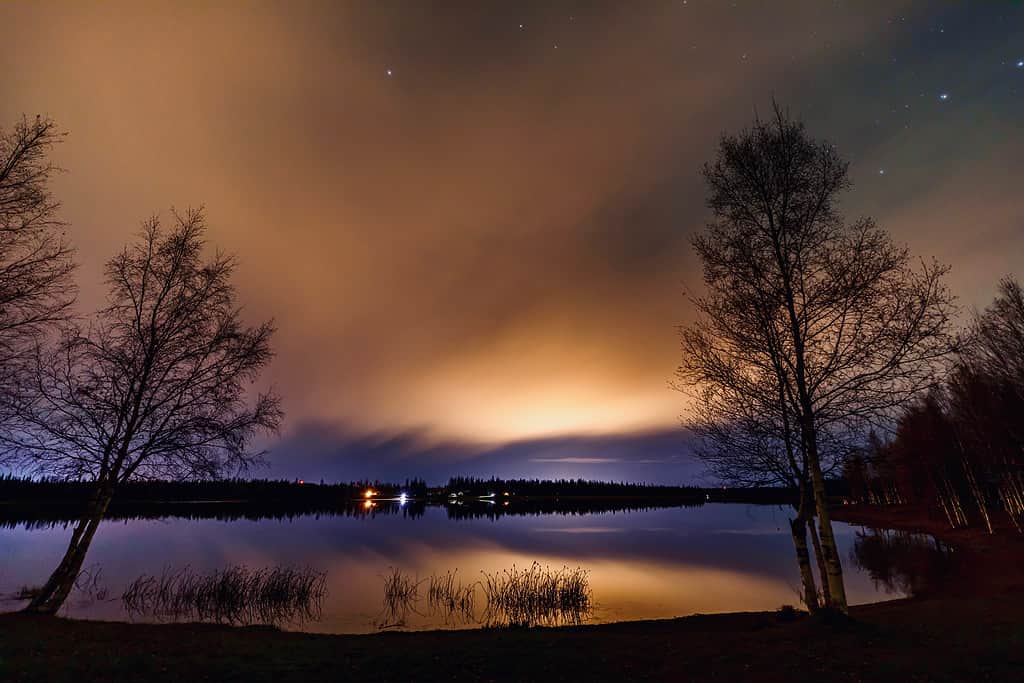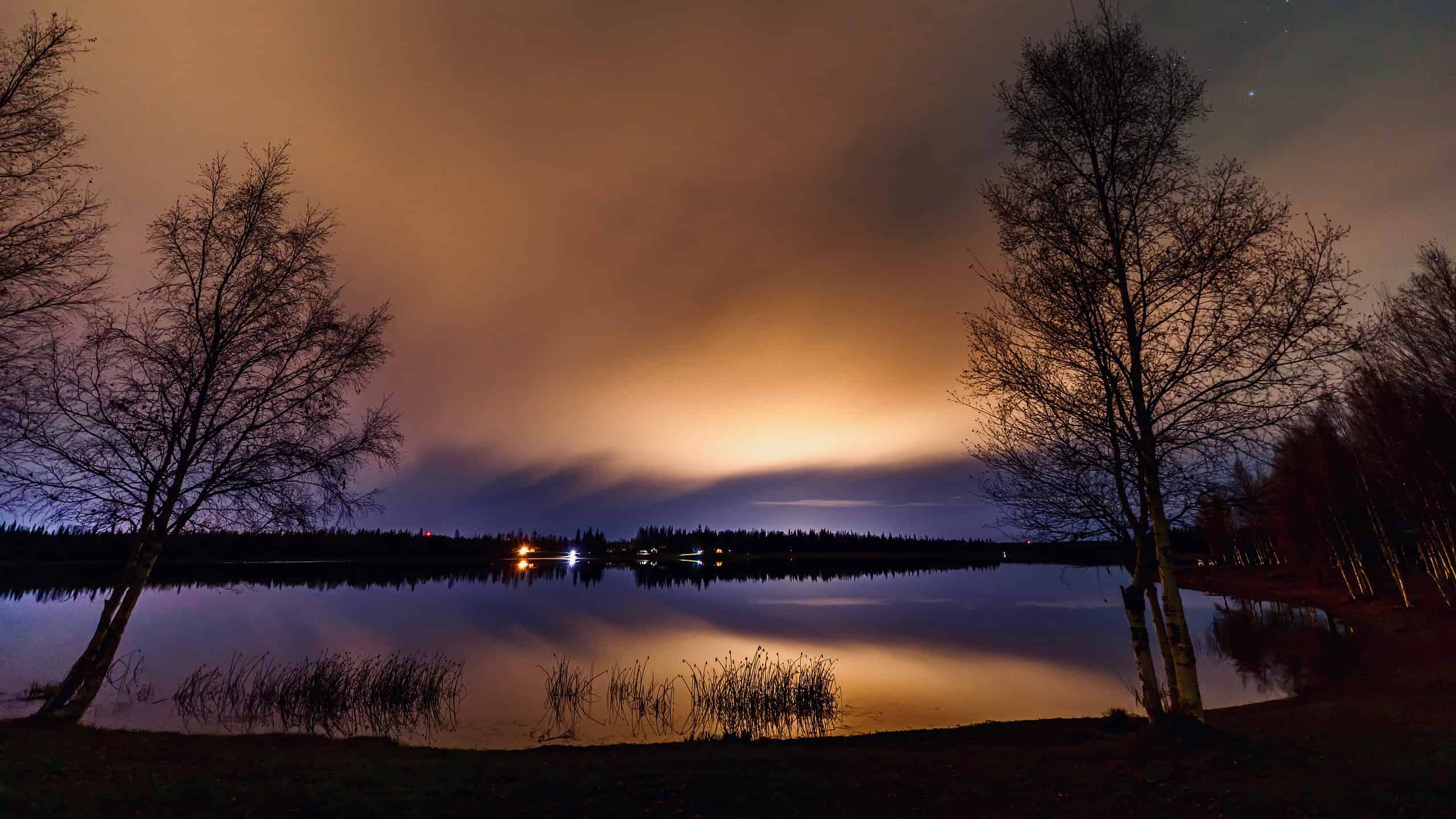
Chena Lake at night, Fairbanks, Alaska.
©Dr_Yu/Shutterstock.com
Alaska’s unusual climate makes The Last Frontier a unique place to visit or live. It is one of the states where people can get paid to live there. In 2022, residents could qualify for up to three thousand two hundred dollars monthly. The Last Frontier has ninety-five percent of its products imported from other regions. Alaska’s agriculture is difficult to farm and cultivate due to its harsh and frigid climate come winter time. With how northern Alaska is in comparison to Canada and Alaska’s counterparts in the United States mainland, they deal with forty days of night and sunlight. So how do Alaskans deal with 40 days of night and sunlight? Keep reading to learn more.
How Does This Affect Alaskan Residents
Seasonal depression affects many individuals. The weather plays a great role in magnifying symptoms. Sunlight exposure regulates serotonin levels. As the body prepares to sleep, it converts the serotonin into melatonin, which aids in great sleep. Seattle goes through something similar with their constant rainy weather. No, they don’t go through forty days of night and sunlight. But Seattle is infamous for their persistent rainy weather and has high cases of seasonal depression. Not to mention, rainy weather can create boredom for people.
Just imagine waking up to get some water at three in the morning to see sunlight passing through your blinds as if it’s 3 p.m. Or if you’re eating lunch at work at 1 p.m. and the street lights are on as if you’re eating lunch at midnight. That’s Alaska during the winter and summertime.
What Are The Long Seasons Like In Alaska?
What makes the topic of the season-long sunlight or darkness in Alaska more interesting is how it can vary where you live. The northernmost city in Alaska, Utqiaġvik, doesn’t see a sunset for eighty days. Vice versa, they won’t see sunlight for more than sixty-five days. When the summer solstice happens in Anchorage, sunrise is at 4:20 a.m., and sunset is at 11:42 p.m. For the winter solstice, the sun rises at 10:14 a.m., and the sun sets at 3:41 p.m. Most areas get five to six hours of sunlight during the winter and the summertime. Now if you’re in the far northern parts of the state, twenty-four hour night and sunlight is a thing.
How Do Alaskan Residents Deal With The Long Nights And Sunlight?
Before we get into the long nights, let’s get to the more unusual long days. Many people in Alaska utilize blackout curtains. “Civil twilight”, which is when the sky is filled with light, but the sun is not visible, lasts for most of the day. If not, all day depending on where you’re at. Alaskan residents tend to oversleep since the sunlight interferes with people’s natural circadian rhythms. The main complaint of Alaskan residents about the extended daytime is that it doesn’t last longer.
Alasa’s exotic situation of their 40 days of night and sunlight is a popular thing for visitors to experience. However, the extended nighttime doesn’t have as much love. Although Alaskans are well accustomed to heavy amounts of snow and freezing temperatures, the extended nighttime isn’t easy for most people.
Vitamin D supplements help give the body much-needed Vitamin D since little to no sunlight is present in the winter. There are light therapy lamps people buy to help produce needed vitamin D and enhance their moods. Some people can feel very fatigued due to the lack of sunlight. Also, the constant darkness can make their day feel like midnight at any time of the day. Few people celebrate the constant darkness like the group that celebrates the constant sunlight.
The UV lights and Vitamin D supplements help with enhancing people’s moods. Studies from the AVEC show that domestic violence in the state picks up around January and February as cabin fever ensues. The Southeast Alaska Regional Health Consortium suggests incorporating exercise in very simple activities to stay active. Some examples are taking a few more laps around the grocery store, working out at home when the weather is too extreme, and taking the stairs rather than using the elevator. Finding ways to constantly exercise can help reduce blood pressure, improve cognitive functioning and mood, reduce arthritis symptoms, and prevent weight gain due to things such as cabin fever.
Summary
How Do Alaskans deal with 40 days of night and sunlight? Here are some examples.
- Blackout curtains for extended daytime periods
- Vitamin D supplements, light therapy lamps, and exercise for the nighttime.
Most areas in Alaska deal with twenty hours of constant night and sunlight during the summers and winters due to the state’s location. However, the northern cities deal with sixty to eighty days of constant night and sunlight. It’s one of the many natural exotic things that makes The Last Frontier a place to visit and potentially live. At least in the night time, the residents can witness the Northern Lights.

Intense northern lights (Aurora borealis) over Lake Laberge, Yukon Territory, Canada, with silhouettes of willows on the lake shore. Aurora borealis can be seen in Alaska, Canada, Sweden, Finland, and most of the very northern parts of Earth.
©Pi-Lens/Shutterstock.com
Another way to combat the seasonal depression during the 40 days of darkness is to eat salmon! Ketchikan, Alaska is the salmon capital of the world. The Omega-3 fatty acids from salmon helps improve heart health and prevent inflammation. A study from the University of Pittsburgh showed that incorporating salmon helped ease symptoms of mild to moderate seasonal depression. Other sources that are high in Omega-3 fatty acids are walnuts and flax seeds.
Thank you for reading! Have some feedback for us? Contact the AZ Animals editorial team.








